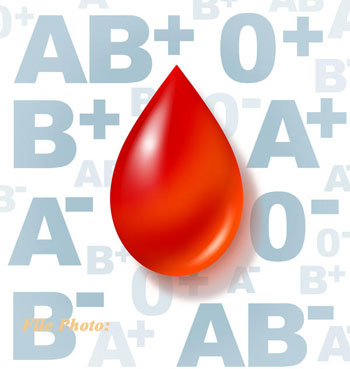Mangalore,july.29: (Special News) Blood type is classified according to the presence or absence of substances inherited from one’s parents, called inherited antigenic substances. The International Society of Blood Transfusion (ISBT) recognizes 32 human blood group systems. The most important are ABO (it determines blood type – A, B, AB and O) and the RhD antigen that denotes the +/- status of the blood type (for example, A- or O+). Here lists some useful blood type charts based on ABO and RhD blood system.
Blood types are classified according to the ABO system:
A: contains A antigens and anti-B antibodies.
B: contains B antigens and anti-A antibodies.
AB: contains both A and B antigens but no antibodies.
O: contains no antigens, but contains both anti-A and anti-B antibodies.
| Blood Type | % of Population | Can Give Blood to | Can Receive Blood from | Chance of Finding a Compatible Donor |
| A+ | 34.3% | A+, AB+ | A+, A-, O+, O- | 80% (4 out of 5) |
| A- | 5.7% | A+, A-,AB+, AB- | A-, O- | 13% (1 out of 8) |
| B+ | 8.6% | B+, AB+ | B+, B-,O+, O- | 60% (3 out of 5) |
| B- | 1.7% | B+, B-,AB+, AB- | B-, O- | 9% (1 out of 12) |
| AB+ | 4.3% | AB+ | Universal recipient (can receive all blood types) | 100% |
| AB- | 0.7% | AB+, AB- | AB-, A-,B-, O- | 14% (1 out of 7) |
| O+ | 38.5% | O+, A+,B+, AB+ | O+, O- | 50% (1 out of 2) |
| O- | 6.5% | Universal donor (can donate to all types) | O- | 7% (1 out of 15) |
Notes:
O+ blood is found in nearly 40% of the population
People with type O blood must receive only type O blood
Type O blood is the only blood type that can be donated to people with other blood types.
Type O- is rare. Only 7% of the population has O- blood.
O- is the “universal donor type”; it is the preferred transfusion for babies and accident victims
Because of its scarcity and ability to be transfused into people with other blood types, there is always an urgent need for type O blood
Blood Type Inheritance Chart:
Your parents determined your particular blood type. Blood type is used in cases of questionable paternity. The following chart explains how:
- ABO Blood Type: determining child’s blood type (when parent’s blood type is known)
| Father’s Blood Type | ||||||
| A | B | AB | O | |||
| Mother’s Blood Type | A | A, O | A, B, AB, O | A, B, AB | A, O | Child’s Blood Type |
| B | A, B, AB, O | B, O | A, B, AB | B, O | ||
| AB | A, B, AB | A, B, AB | A, B, AB | A, B | ||
| O | A, O | B, O | A, B | O |
- ABO Blood Type: determining father’s blood type in questions of paternity
| Child’s Blood Type | ||||||
| A | B | AB | O | |||
| Mother’s Blood Type | A | A, B, AB, O | B, AB | B, AB | A, B, O | Father’s Blood Type MUST Be: |
| B | A, AB | A, B, AB, O | A, AB | A, B, O | ||
| AB | A, B, AB, O | A, B, AB, O | A, B, AB | — | ||
| O | A, AB | B, AB | — | A, B, 0 |
Notes:
For example, an AB mother and an O father can have a child with a blood type of A or B, but not O. An O child and an A mother means that the father’s blood type must be A, B or O (ruling out men with an AB blood type).
- The Rh System
The Rh System is used to make the classification system more precise. The Rh factor, or the positive/negative aspect of blood, is inherited separately from the ABO classification.
| Mother’s Type | ||||
| Rh + | Rh – | |||
| Father’s Type | Rh + | Rh+, Rh- | Rh+, Rh- | Child’s Type |
| Rh – | Rh+, Rh- | Rh- | ||
Notes:
- The parents’ Rh factors may be incompatible. It is important for pregnant women to have a blood group test so that any complications don’t go untreated.
- Rh- women who are of childbearing age should only receive Rh- transfusions to prevent complications with pregnancy.



